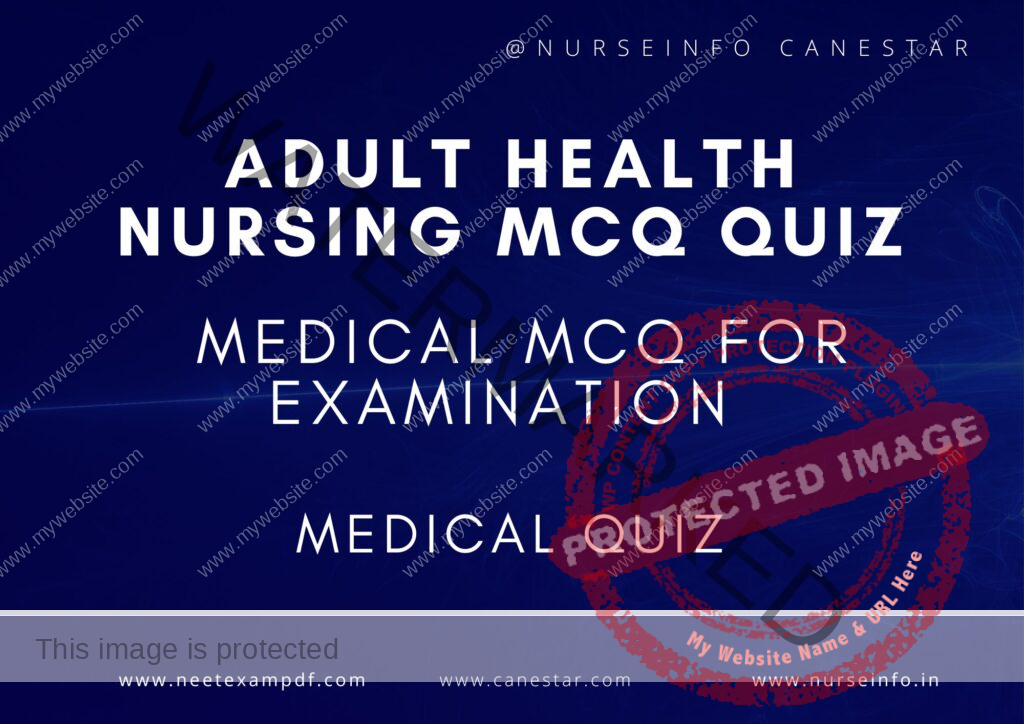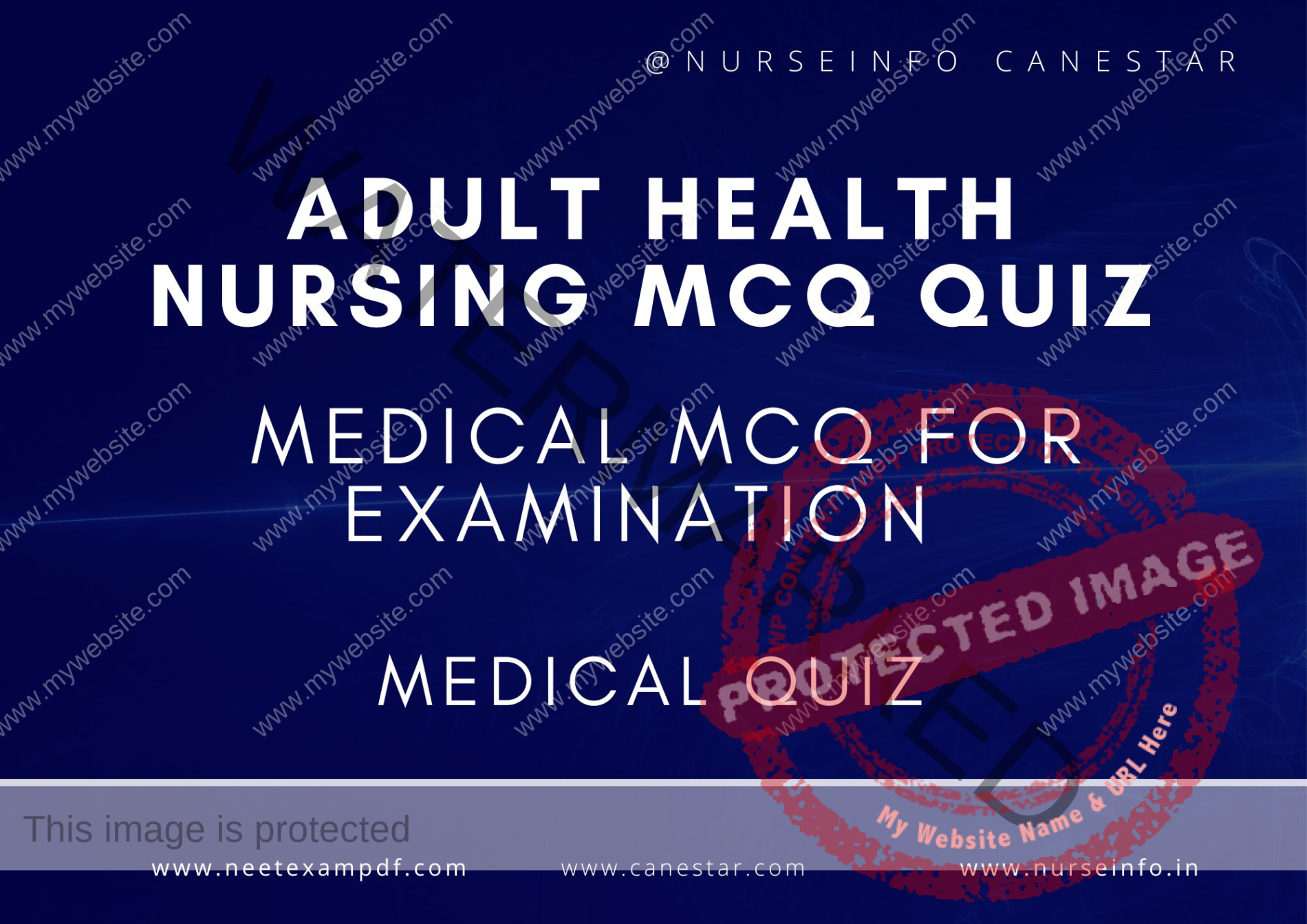MULTIPLE CHOICE QUESTIONS ON ADULT HEALTH NURSING QUIZ – MCQS WITH RATIONALE ANSWER – ADULT HEALTH NURSING MCQ QUESTIONS
MCQ FOR ADULT HEALTH NURSING QUIZ
These mcqs are prepared exclusively for medical professionals for exam preparation. MCQ is helpful to remember the concept on adult health nursing mcq quiz. This multiple choice questions are helpful for preparation for DHA, PROMETRIC, MOH, HAAD, NCLEX, Medical, NEET and Nursing EXAMINATION
ADULT HEALTH NURSING MCQ QUIZ
Adult Nursing MCQs with Rationale
Which of the following is the best indicator of fluid balance in an adult patient?
a) Daily weight
b) Skin turgor
c) Blood pressure
d) Pulse rate
Answer: a) Daily weight
Rationale: Daily weight is the most accurate indicator of fluid balance as it reflects changes in fluid retention or loss.
Which electrolyte imbalance is associated with muscle weakness and ECG changes such as a flattened T wave?
a) Hyperkalemia
b) Hypokalemia
c) Hypercalcemia
d) Hypocalcemia
Answer: b) Hypokalemia
Rationale: Hypokalemia can cause muscle weakness and characteristic ECG changes like flattened T waves and U waves.
What is the primary goal of nursing management for a patient with congestive heart failure?
a) Increase fluid intake
b) Improve cardiac output
c) Promote weight gain
d) Reduce urine output
Answer: b) Improve cardiac output
Rationale: The primary goal in managing congestive heart failure is to improve cardiac output and reduce symptoms of fluid overload.
Which of the following interventions is most important for preventing pressure ulcers in bedridden patients?
a) Increasing caloric intake
b) Regular repositioning
c) Providing a high-protein diet
d) Applying moisturizing lotion
Answer: b) Regular repositioning
Rationale: Regular repositioning helps to relieve pressure on vulnerable areas and is the most effective measure to prevent pressure ulcers.
What is the best method to confirm placement of a nasogastric (NG) tube?
a) Checking the pH of aspirated fluid
b) Injecting air and listening for a gurgling sound
c) Observing for patient discomfort
d) Obtaining a chest x-ray
Answer: d) Obtaining a chest x-ray
Rationale: A chest x-ray is the most reliable method to confirm NG tube placement.
Which lab value is most critical to monitor in a patient receiving warfarin therapy?
a) Hemoglobin
b) Platelet count
c) INR (International Normalized Ratio)
d) WBC (White Blood Cell) count
Answer: c) INR (International Normalized Ratio)
Rationale: INR is used to monitor the effectiveness and safety of warfarin therapy, ensuring the patient remains within the therapeutic range.
Which of the following is a common side effect of opioid analgesics?
a) Diarrhea
b) Hypertension
c) Constipation
d) Tachycardia
Answer: c) Constipation
Rationale: Opioid analgesics commonly cause constipation due to their effect on the gastrointestinal tract.
What is the priority nursing action for a patient experiencing an anaphylactic reaction?
a) Administering oxygen
b) Monitoring blood pressure
c) Providing oral fluids
d) Administering epinephrine
Answer: d) Administering epinephrine
Rationale: Epinephrine is the first-line treatment for anaphylaxis as it quickly counteracts the severe allergic response.
Which of the following is an important consideration when providing care for a patient with a chest tube?
a) Clamping the chest tube every hour
b) Keeping the drainage system below chest level
c) Changing the drainage system daily
d) Encouraging frequent deep breathing exercises
Answer: b) Keeping the drainage system below chest level
Rationale: Keeping the drainage system below chest level ensures proper drainage of air and fluid from the pleural space.
In patients with chronic obstructive pulmonary disease (COPD), which oxygen delivery device is typically recommended to avoid suppressing the respiratory drive?
a) Non-rebreather mask
b) Nasal cannula
c) Simple face mask
d) Venturi mask
Answer: d) Venturi mask
Rationale: The Venturi mask delivers a precise concentration of oxygen, preventing the risk of suppressing the respiratory drive in COPD patients.
Which of the following is a priority assessment in a patient receiving intravenous (IV) fluid therapy?
a) Capillary refill time
b) Urine specific gravity
c) Lung auscultation
d) Skin temperature
Answer: c) Lung auscultation
Rationale: Monitoring lung sounds is crucial to detect fluid overload and the development of pulmonary edema in patients receiving IV fluid therapy.
Which nursing intervention is essential for a patient with a urinary catheter to prevent infection?
a) Increasing fluid intake
b) Regular perineal care
c) Limiting catheter use to 48 hours
d) Administering prophylactic antibiotics
Answer: b) Regular perineal care
Rationale: Regular perineal care helps maintain hygiene and reduces the risk of urinary tract infections in patients with urinary catheters.
What is the primary goal of pain management in postoperative adult patients?
a) Eliminate all pain
b) Reduce pain to a tolerable level
c) Prevent addiction to pain medication
d) Minimize the use of opioids
Answer: b) Reduce pain to a tolerable level
Rationale: The primary goal is to reduce pain to a level that allows the patient to participate in recovery activities while avoiding significant side effects.
Which of the following is a common cause of metabolic acidosis in adult patients?
a) Excessive vomiting
b) Diabetic ketoacidosis
c) Overuse of antacids
d) Hyperventilation
Answer: b) Diabetic ketoacidosis
Rationale: Diabetic ketoacidosis leads to the accumulation of ketoacids in the body, resulting in metabolic acidosis.
Which of the following interventions is appropriate for a patient experiencing a seizure?
a) Placing a tongue blade in the mouth
b) Restraining the patient’s movements
c) Turning the patient to the side
d) Providing sips of water during the seizure
Answer: c) Turning the patient to the side
Rationale: Turning the patient to the side helps maintain an open airway and prevents aspiration during a seizure.
Which type of diet is recommended for a patient with chronic renal failure?
a) High-protein diet
b) Low-sodium diet
c) High-potassium diet
d) Low-calcium diet
Answer: b) Low-sodium diet
Rationale: A low-sodium diet helps manage fluid balance and blood pressure in patients with chronic renal failure.
What is the most important initial assessment for a patient with suspected myocardial infarction (MI)?
a) Blood pressure measurement
b) Cardiac enzyme levels
c) Pain assessment
d) Electrocardiogram (ECG)
Answer: d) Electrocardiogram (ECG)
Rationale: An ECG is crucial in diagnosing an MI as it provides immediate information about the heart’s electrical activity and potential damage.
Which of the following is a key sign of hypoglycemia in an adult patient with diabetes?
a) Increased thirst
b) Frequent urination
c) Confusion
d) Weight loss
Answer: c) Confusion
Rationale: Confusion, along with symptoms like sweating, tremors, and palpitations, is a common sign of hypoglycemia.
Which of the following actions should a nurse take first when a patient is found unresponsive and not breathing?
a) Call for help
b) Check for a pulse
c) Begin chest compressions
d) Open the airway
Answer: a) Call for help
Rationale: The first action is to call for help to ensure that additional resources are mobilized while beginning resuscitation efforts.
Which of the following medications is commonly used to reduce the risk of stroke in patients with atrial fibrillation?
a) Aspirin
b) Warfarin
c) Atorvastatin
d) Metoprolol
Answer: b) Warfarin
Rationale: Warfarin is an anticoagulant used to reduce the risk of thromboembolic events, such as stroke, in patients with atrial fibrillation.


